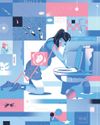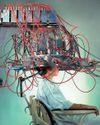
Mind-reading machines have been around for a long time. In 1895, scientist Julius Emmner believed his machine could record patterns of thoughts in the same way that sound could be recorded. Emmner took inspiration from the phonautograph, which plucked sound waves out of the air and committed their waveforms to paper.
It seemed plausible to Emmner and the world at large that he might be able to do the same with thought. His machine was supposed to record thoughts as "mental photographs", which could be replayed to someone who would receive them "in an unconscious manner".
According to Emmner, mindreading was solved: all thoughts could be recorded and nothing could be hidden. "The murderer will be confronted with proof of his crime and the punishment will be an easy task."
The state of the art
Despite the publicity it generated, Emmner's machine was soon forgotten because it didn't work-reading minds is not as simple as recording sound. Our brains have around 100 billion neurons and countless other cells that help us to remember, feel and think. We're still unlocking the mysteries of exactly how and where our thoughts are held and, to make matters trickier, we don't have access to the state of the cells in our heads, so we don't know what they're doing at any given time.
What we do know is that our brains affect our bodies and the closest thing we have to a mind-reading machine, the polygraph (more commonly and inaccurately known as a 'lie detector'), measures factors such as respiration, perspiration, skin conductivity, blood pressure and heart rate. The theory behind it is that, when we lie, we become anxious and our bodies undergo measurable involuntary physiological changes. But even the polygraph is unreliable and often inadmissible as evidence.
This story is from the July/August 2024 edition of Very Interesting.
Start your 7-day Magzter GOLD free trial to access thousands of curated premium stories, and 9,000+ magazines and newspapers.
Already a subscriber ? Sign In
This story is from the July/August 2024 edition of Very Interesting.
Start your 7-day Magzter GOLD free trial to access thousands of curated premium stories, and 9,000+ magazines and newspapers.
Already a subscriber? Sign In

TAKE IT SLOW
Slow running is a fitness trend with some hard and fast science behind it

Physics, AI and music share a common thread. You just have to know where to look
Studying science can lead you in many directions and open doors to unexpected possibilities along the way

BED BUGS VS THE WORLD
When bloodthirsty bed bugs made headlines for infesting Paris Fashion Week in 2023, it shone a spotlight on a problem that's been making experts itch for decades: the arms race going on between bed bugs and humans

Kids are the key to understanding obesity. But we need more of their genes...
We can unravel the role that bodyweight plays in disease, but we need a bigger, more diverse, sample of genetic material to do so

COVID inquiry: What did we learn and what can we do better in future pandemics?
Masks, social distancing, lockdowns... how effective was the UK's response to the COVID-19 pandemic?

One hormone could be the key that unlocks a cure for morning sickness
The nausea and vomiting that, in extreme cases, can endanger mothers and babies might soon be just a memory

THE WORLD'S WEIRDEST CREATURES
Under the sea and upon the land, some animals look - to us - pretty strange...

WHEN MIND AND MACHINE COLLIDE
First, Elon Musk wanted to make electric cars ubiquitous, then he wanted to make space exploration a private enterprise. Now, with Neuralink, his newest venture, Musk hopes to merge humans and artificial intelligence. Turns out, it might not be such a crazy idea...

COME OUT OF YOUR SHELL
Social anxiety is more than just being shy. It's a phobia born out of our evolutionary past. But that raises a puzzling question: why do so many of us fear human interaction when we're supposed to be the most sociable species on the planet?

SPACE ODDITIES
Take a tour of the weirdest spots in the universe, where the 'normal' rules don't apply. Places that squeeze time, blow bubbles and even rain glass... sideways